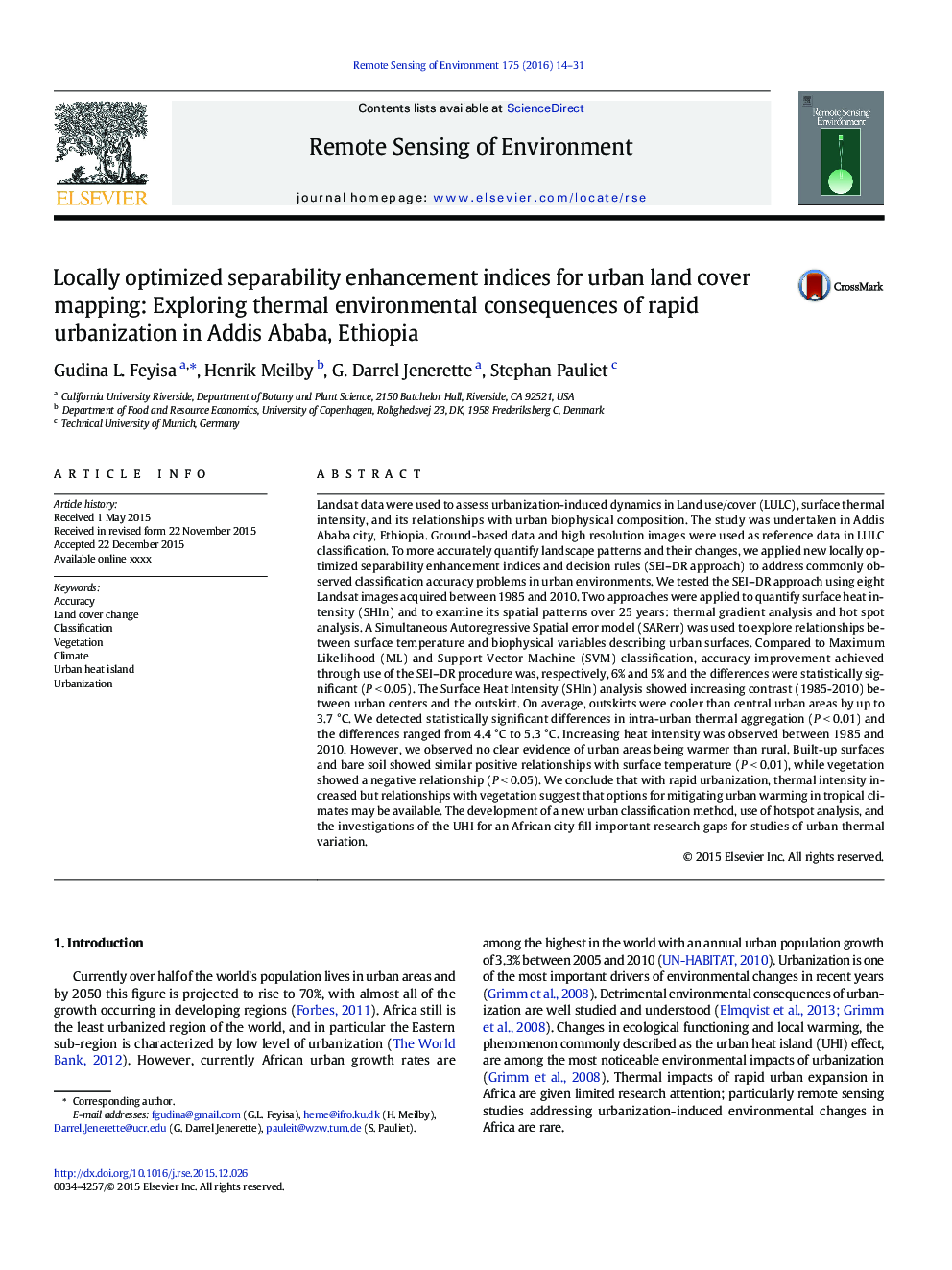| کد مقاله | کد نشریه | سال انتشار | مقاله انگلیسی | نسخه تمام متن |
|---|---|---|---|---|
| 6345601 | 1621225 | 2016 | 18 صفحه PDF | دانلود رایگان |
عنوان انگلیسی مقاله ISI
Locally optimized separability enhancement indices for urban land cover mapping: Exploring thermal environmental consequences of rapid urbanization in Addis Ababa, Ethiopia
ترجمه فارسی عنوان
شاخص های افزایش جداسازی محلی بهینه برای پوشش نقشه های زمین شهری: بررسی پیامدهای محیطی شهرنشینی سریع در ادیس آبابا، اتیوپی
دانلود مقاله + سفارش ترجمه
دانلود مقاله ISI انگلیسی
رایگان برای ایرانیان
کلمات کلیدی
دقت، تغییر زمین زمین، طبقه بندی، زندگی گیاهی، آب و هوا، جزیره گرمایی شهری، شهرنشینی،
موضوعات مرتبط
مهندسی و علوم پایه
علوم زمین و سیارات
کامپیوتر در علوم زمین
چکیده انگلیسی
Landsat data were used to assess urbanization-induced dynamics in Land use/cover (LULC), surface thermal intensity, and its relationships with urban biophysical composition. The study was undertaken in Addis Ababa city, Ethiopia. Ground-based data and high resolution images were used as reference data in LULC classification. To more accurately quantify landscape patterns and their changes, we applied new locally optimized separability enhancement indices and decision rules (SEI-DR approach) to address commonly observed classification accuracy problems in urban environments. We tested the SEI-DR approach using eight Landsat images acquired between 1985 and 2010. Two approaches were applied to quantify surface heat intensity (SHIn) and to examine its spatial patterns over 25 years: thermal gradient analysis and hot spot analysis. A Simultaneous Autoregressive Spatial error model (SARerr) was used to explore relationships between surface temperature and biophysical variables describing urban surfaces. Compared to Maximum Likelihood (ML) and Support Vector Machine (SVM) classification, accuracy improvement achieved through use of the SEI-DR procedure was, respectively, 6% and 5% and the differences were statistically significant (P < 0.05). The Surface Heat Intensity (SHIn) analysis showed increasing contrast (1985-2010) between urban centers and the outskirt. On average, outskirts were cooler than central urban areas by up to 3.7 °C. We detected statistically significant differences in intra-urban thermal aggregation (P < 0.01) and the differences ranged from 4.4 °C to 5.3 °C. Increasing heat intensity was observed between 1985 and 2010. However, we observed no clear evidence of urban areas being warmer than rural. Built-up surfaces and bare soil showed similar positive relationships with surface temperature (P < 0.01), while vegetation showed a negative relationship (P < 0.05). We conclude that with rapid urbanization, thermal intensity increased but relationships with vegetation suggest that options for mitigating urban warming in tropical climates may be available. The development of a new urban classification method, use of hotspot analysis, and the investigations of the UHI for an African city fill important research gaps for studies of urban thermal variation.
ناشر
Database: Elsevier - ScienceDirect (ساینس دایرکت)
Journal: Remote Sensing of Environment - Volume 175, 15 March 2016, Pages 14-31
Journal: Remote Sensing of Environment - Volume 175, 15 March 2016, Pages 14-31
نویسندگان
Gudina L. Feyisa, Henrik Meilby, G. Darrel Jenerette, Stephan Pauliet,
